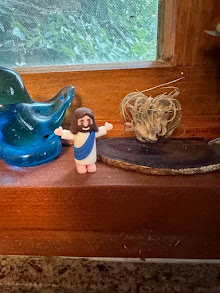The storms of June following the constant rains of May have left our country roads in quite a state. You can mess up the alignment of your minivan dropping off the pavement to the erstwhile gravel road. Your four wheel drive independent suspension will loosen your false teeth on the washboards of the downhill slopes. Even the most seasoned skier would have a difficult time navigating the moguls at the top of the rises. A driver plays Russian roulette where the tubes have washed out and the road narrows to one car wide. On my way to work this morning, 160th, the gravel leading to the greenhouse, reminds me of nothing so much as the Oregon trail ruts carved deep into the limestone at Guernsey, Wyoming. And thinking of the Oregon trail.....
Like many of us, I've visited our nation's Capitol and viewed with reverence and respect the memorials and monuments to our nation's founding and history. Each and every time I mount the steps to the Lincoln Memorial, I get goosebumps reading the words of the Second Inaugural Address on the marble wall. However strenuous the gauntlet of security surrounding the Capitol, it is still the people's house. The walls, the intricately tiled floors, the murals, the well worn desks: despite the uniformed attendants and bustling, over busy factotums , the subtext of the surroundings is " you have every right to feel at home here." The streets fill every morning with the worker bees of the government, but the city belongs to the tourists. In Washington, D.C., our history is concentrated, piled up like a seven layer salad. And like that dish, mixing the ingredients may ruin the appearance, but improves the experience. That's how I feel eating lunch at the Old Ebbitts Grill: new seating in the enclosed atrium, old style wait staff, antique bar. Or visiting the American Art Museum/Portrait Gallery nee' Patent Building. Or perusing the book I have from the National Archives titled 'Washington old and new'.
But wait. Washington, D.C. is not the whole story. The story of America found on the Mall is the Readers Digest condensed version: it cannot do justice to the natural physical spaciousness and enormity of America and the way it formed the American character and experience. Instead of walking the National Mall of our east coast, one must hit the highways and follow those seekers on the Oregon Trail.
Maybe I put too much store in the pioneers. Perhaps this is a provincial prejudice of itself. After all, when you live just north of the home of the Pony Express, when you cross the proverbial Wide Missouri every little whip stitch, when Lewis and Clark's Indian tribes named your neighboring counties, when the flat sandy Platte empties nearby; how could you fail emphasize and honor the super highway of the last century?
Not just recognize, but also realize how many of the differences between the coasts in our present day derive from the differing perceptions of the scope and scale of our modern country. Those folks living at the end of the section roads in the Sand Hills are not newcomers; they have roots as deep as the grasses that hold the ancient dunes in place. You think Nebraska is long on I-80? The Oregon Trail covered even more miles on the wandering south side of the Platte; the Mormons kept themselves separate on the north side. I'm sure those 400 odd miles seemed long, but as the bountiful pasture and water of the east dwindled as the land rose and the humidity dropped, it could and did get worse. Think of those folks; never spent a season in a truly dry land. Never lived through searing winds of 40 mph day after day. Never saw the storms rise up from nothing over the horizon and drop hail the size of hen's eggs.
We've been to Ash Hollow and seen the broken land the dried and split wagons traversed. A sobering warm up for the slope of the Rockies. How bizarre did the monuments of Chimney Rock and Scotts Bluff appear? Or perhaps the travelers didn't mark this passage; unlike our windshield surveys on pavement, Chimney Rock and Scotts Bluff were landmarks for days on end.
Across the Platte in Wyoming, the rocks at Guernsey concentrate the impact of the wagon wheels. If you stand at the foot of the rocks, the ruts are four foot deep. The names of the travelers are carved in that same stone in block letters with dates attached. What a leap of faith or foolishness!! Here in eastern Wyoming, the topography is moderate though the eastern forests and plentiful wood are but a distant memory.
The next stop for weary travelers would be Fort Laramie, a gathering place for military, Indians, and emigrants. Fort Laramie looks much as it did 150 years ago: tremendously exposed, big sky, big prairie near a modest copse of cottonwoods. There is little to protect or screen the wooden enclave: the landscape is reduced to its lowest terms; you are in the West.
Even more evocative of the stark and brutal journey is the landscape farther west in Wyoming. The current highway following the Trail can be lonely in the 21st century; no towns exist for miles, though in classic Wyoming fashion, the widest spot of the road gets large font on the state map. The terrain is broken, the names foreboding: Rattlesnake Hills, Devil's Gate. Independence Rock sits in the middle of this landscape, imposing and graffiti-ed. We arrived at Independence Rock one morning when the shadows were still long. The parking lot was empty and the air silent. Unlike a midwestern summer morning, there was no bird song and no dew, just the crunching of our footsteps on the path. For miles past Casper, we'd seen no sign of human habitation or occupation except the signs for the Pathfinder ranch. The Rattlesnake Hills were black and barren. The highway both directions was empty. It was not hard to imagine how endless the miles would seem when laboring through this desolation.
For the modern traveler, it is but a short drive on to the Devil's Gate, a gash in the rocks before the welcoming meadows and water of the Sweetwater River. But the wagons and teams would take an entire day to make the distance, a pace that became even more labored as the summer wore on, the days shortened and the mountains loomed.
I can hardly imagine what drove those people to travel such a distance. These were wanderers, drifters, dreamers and the children of such restless folk uprooted from their native soils. They took leaps of ignorance and faith and could never have known how ill prepared their best efforts were. Was Oregon or California really worth this sacrifice? Apparently so, because the prairies still bear markings from the impact of the exodus even today. Where are those doughty long suffering souls today? They are still in our bones and in our pretty well universal can-do approach to circumstances. Every time we pack up our families and belongings and take on a change of life and location, we pay homage to our forebears. We may not recognize ourselves in the marbled halls of our seat of government. But when we drive the thousand miles from the Missouri River to the Devil's Gate, we do. We are far removed in time from the emigrants of the Oregon Trail, but we admire their persistence, their spirit, and their hope for a better life for their loved ones.
Subscribe to:
Post Comments (Atom)

























No comments:
Post a Comment